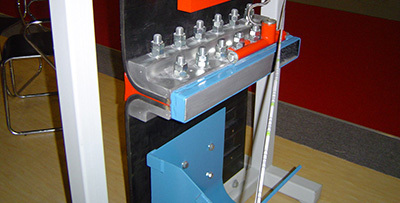News Center
Hezi technology focuses on the research and development of "rapid seamless conveyor belt joint sleeve" innovative technology project

NEWS CENTER

News Details
Enhancing Efficiency: The Role of Quality Conveyor Belt Fasteners in the Chemical and Rubber Industries
Release time:
2025-05-08
Enhancing Efficiency: The Role of Quality Conveyor Belt Fasteners in the Chemical and Rubber Industries In the competitive landscape of the chemical and rubber industries, operational efficiency is paramount. One often-overlooked component that plays a crucial role in optimizing production processes is the conveyor system, specifically the conveyor belt fasteners. These small but mighty components
Enhancing Efficiency: The Role of Quality Conveyor Belt Fasteners in the Chemical and Rubber Industries
In the competitive landscape of the chemical and rubber industries, operational efficiency is paramount. One often-overlooked component that plays a crucial role in optimizing production processes is the conveyor system, specifically the conveyor belt fasteners. These small but mighty components ensure the seamless operation of conveyor belts, which are essential for transporting materials and products. In this article, we will explore the various aspects of conveyor belt fasteners, their significance, and how investing in quality fasteners can enhance efficiency in your operations.
Table of Contents
- 1. What Are Conveyor Belt Fasteners?
- 2. Types of Conveyor Belt Fasteners
- 3. The Importance of Quality Materials in Fasteners
- 4. Advantages of Using High-Quality Fasteners
- 5. Best Practices for Selecting Conveyor Belt Fasteners
- 6. Maintenance Tips for Conveyor Belt Fasteners
- 7. Case Studies: Success Stories of Using Quality Fasteners
- 8. Conclusion
- 9. Frequently Asked Questions
1. What Are Conveyor Belt Fasteners?
Conveyor belt fasteners are specialized mechanical devices used to join two ends of a conveyor belt together. By creating a continuous loop, these fasteners facilitate the smooth movement of materials along the conveyor system. Fasteners come in various sizes, shapes, and materials, tailored to the specific requirements of the industry and the materials being transported. Understanding the types of fasteners available is essential for optimizing performance and ensuring long-term reliability.
2. Types of Conveyor Belt Fasteners
Different types of conveyor belt fasteners are designed to meet the varying demands of the chemical and rubber industries. Here are some common categories:
2.1 Mechanical Fasteners
Mechanical fasteners are the most widely used type. They include clamps, pins, and buckles that secure the belt ends together. Their installation is relatively straightforward and can often be executed without specialized tools.
2.2 Splice Fasteners
Splice fasteners ensure a seamless connection between belt ends. They are particularly beneficial in high-load applications, providing strength and durability to withstand heavy usage.
2.3 Welded Fasteners
Welded fasteners create a permanent bond between the belt ends. They are commonly used in applications requiring a smooth surface to minimize friction. However, this method requires specialized equipment and expertise for proper installation.
2.4 Specialty Fasteners
These fasteners are designed for specific applications, such as food-grade belts or belts exposed to harsh chemicals. Understanding the unique requirements of your operation will help you select the right specialty fasteners.
3. The Importance of Quality Materials in Fasteners
Quality materials are essential for the longevity and performance of conveyor belt fasteners. Fasteners made from durable materials such as stainless steel or high-grade polymers resist corrosion, wear, and environmental challenges. Investing in high-quality fasteners can yield significant long-term savings by reducing the frequency of replacements and maintenance.
4. Advantages of Using High-Quality Fasteners
Opting for high-quality conveyor belt fasteners offers numerous advantages:
4.1 Increased Durability
High-quality fasteners are engineered to withstand the rigors of industrial environments. Their durability translates into a longer lifespan for both the fasteners and the conveyor belts themselves.
4.2 Enhanced Safety
Reliable fasteners minimize the risk of conveyor belt failure, which can lead to unsafe working conditions. Quality fasteners help ensure that the conveyor operates smoothly, protecting both machinery and personnel.
4.3 Improved Performance
With high-quality fasteners, conveyor belts can maintain their tension and alignment more effectively. This consistency leads to smoother material handling and reduced downtime caused by maintenance or belt replacements.
4.4 Cost-Effectiveness
While investing in quality fasteners may incur a higher upfront cost, the long-term savings from reduced maintenance, fewer replacements, and enhanced efficiency far outweigh the initial expenditure.
5. Best Practices for Selecting Conveyor Belt Fasteners
Choosing the right conveyor belt fasteners involves careful consideration of several factors:
5.1 Assessing Application Requirements
Understand the specific demands of your application, including load capacity, speed, and material type. This assessment will guide you in selecting the most suitable fasteners.
5.2 Evaluating Material Compatibility
Ensure that the fasteners you select are compatible with the materials being transported and the environmental conditions present in your facility.
5.3 Consulting Experts
Involving a conveyor system expert can provide valuable insights into the best fasteners for your operation. Their expertise will help you navigate the various options available.
5.4 Considering Installation and Maintenance
Evaluate the installation and maintenance requirements of the fasteners you are considering. Some fasteners may require specialized tools or techniques, which can affect your operational efficiency.
6. Maintenance Tips for Conveyor Belt Fasteners
To ensure the longevity and performance of your conveyor belt fasteners, adhering to a maintenance routine is crucial:
6.1 Regular Inspections
Conduct regular inspections of your conveyor system to identify any signs of wear or damage in the fasteners. Early detection can prevent significant issues down the line.
6.2 Cleanliness
Keep the area around the conveyor system clean and free from debris. Accumulation of materials can lead to fastener damage and impede the system’s performance.
6.3 Lubrication
Proper lubrication can reduce friction and wear on fasteners, extending their lifespan. Ensure that you follow manufacturer guidelines for lubrication practices.
6.4 Replacement Planning
Implement a proactive replacement schedule for fasteners based on their expected lifespan and wear rates. Keeping spare fasteners on hand can minimize downtime during replacements.
7. Case Studies: Success Stories of Using Quality Fasteners
To illustrate the benefits of quality conveyor belt fasteners, we present case studies from notable companies in the chemical and rubber industries:
7.1 Case Study 1: Chemical Manufacturing Plant
A leading chemical manufacturing plant implemented high-quality metal fasteners and noted a 30% reduction in maintenance costs over a year. The longevity of the fasteners resulted in less frequent replacements and increased overall efficiency.
7.2 Case Study 2: Rubber Production Facility
A rubber production facility opted for specialty fasteners designed for high-temperature applications. This decision led to minimized downtimes due to belt failures, significantly enhancing production rates.
8. Conclusion
In conclusion, quality conveyor belt fasteners play an indispensable role in enhancing efficiency within the chemical and rubber industries. By understanding the various types of fasteners, their benefits, and best practices for selection and maintenance, companies can improve their operational performance and minimize costs. Investing in high-quality fasteners is not merely a choice; it is a strategic decision that can lead to substantial long-term gains in efficiency and safety.
9. Frequently Asked Questions
9.1 What materials are best for conveyor belt fasteners?
The best materials for conveyor belt fasteners include stainless steel, carbon steel, and high-grade polymers, depending on the specific application and environmental conditions.
9.2 How often should I inspect conveyor belt fasteners?
Regular inspections should be conducted at least once a month, or more frequently if the conveyor system operates under heavy loads or harsh conditions.
9.3 Can I replace fasteners myself?
While some fasteners can be replaced easily, others may require specialized equipment or knowledge. It’s advisable to consult with an expert for complex installations.
9.4 What are the signs that fasteners need replacement?
Signs include visible wear, corrosion, misalignment of the conveyor belt, or frequent belt slippage. Early replacement can prevent further damage.
9.5 Do high-quality fasteners really save money?
Yes, high-quality fasteners reduce maintenance needs and downtime, leading to significant long-term cost savings for your operation.
Next Page

Recommend News





























